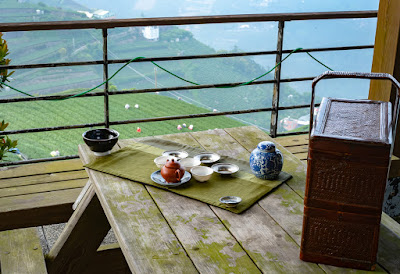There was no shortage of manpower in Alishan this year. Big groups of workers help harvest the leaves faster, when the weather is suitable. This helps produce a more consistent flavor than when the leaves are harvested slowly.
The young ladies are mostly from Vietnam or Indonesia and seemed pretty happy with their work.
There were also some older ladies from Taiwan lending a hand.
The harvest on my farmer's plantation didn't go very smoothly that day. It didn't have much to do with the workers or the weather on that day. Can you spot the problem in the picture below?
I didn't see it right away. The farmer showed me that some stems were missing their bud! Can you see it above? If not, look at the two leaves on my hand. The one on the left is normal, but the one on the right is missing the bud! This problem was caused by a 10 minutes episode of hail at the end of March! The small ice drops have damaged the plantation by destroying the most fragile part, the buds.
There's no hail in Taipei or at low altitude in Taiwan. However, in the mountains, this kind of extreme weather event is more likely and will reduce the quality of the tea that is produced.
Frost during spring, when the leaves have started to grow, is another problem that can happen in the high mountains. (I've shown the negative consequences of frost last year.)
On the other hand, when it's very cold and snows in winter, the defense mechanism of the tea trees actually help strengthen the next leaves that the tree will produce in spring!
This is another reason that makes good high mountain Oolong taste both light and thick!
Producing the perfect leaf takes skill and luck with the weather. Finding such tea means you can't rely on one farmer alone. Because even if he's skilled, he might be unlucky! The hail damage in this plantation explains why I wasn't satisfied with what I was tasting. That's when you have to be persistent and insist on top quality. It's like with photography: it's at the end of this long day, that the light became the best and allowed me to take this wonderful picture.
So, after repeated tastings I decided to visit an other farmer I know in the region. There, I found exactly the wonderfully fragrant and smooth Alishan Oolong I had been searching! This kind of delicious buttery and floral flavor is quite unusual this spring.
Now I could take a well deserved rest and enjoy my high mountain Alishan Oolong on a spot overlooking the tea plantations of ChangShuHu!
My Green green green Chabu fits wonderfully on this wooden table where some moss starts to grow!
The golden brew lights up when a ray of sun escapes the clouds. This high mountain Oolong echoes the sweetness of sunshine.
The afternoon ends with this stunning Alishan Oolong: it's a glorious finish for long day of exploration, tastings and photography!
A foggy night is about to set in Alishan, but I'm seeing stars and far away galaxies in my Chaxi!
 |
| Black glazed bowl by Michel François |

























3 comments:
Hi Stéphane,
I'm curious to understand more about the quality of 'thickness' in brewed tea. What is it and what contributes to it?
Here you mention that the extra cold, snowy winter contributes and I've also seen you mention on your site that the right Yixing clay pot can make a tea taste smoother and thicker. I've certainly experienced it with old Puer, aged oolong, and recently with DYL oolong but certainly wouldn't know how to explain it!
Best,
Elisabeth
Hi Elisabeth,
Thickness comes with concentration of flavors. This happens first in the leaf itself. Healthy leaves that had to battle the cold... will have more concentrated flavors.
Second, the tea brew can have more flavors if the teapots extracts more flavors from the leaves. This is what good Yixing clay does and at the same time it refines the taste by retaining bad flavors within its pores.
An excellent cup happens when you combine both thickness from the leaf and the brew!
Thanks, that makes sense. Very interesting!
Post a Comment